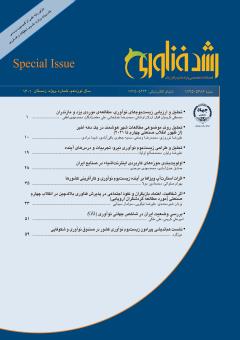بررسی وضعیت ایران در شاخص جهانی نوآوری (GII)
محورهای موضوعی : انتقال فناوري و تجاريسازي پژوهشامیرعلی کریمی 1 * , علی ملکی 2
1 - دانشگاه علم و صنعت ایران
2 - دانشگاه صنعتی شریف
کلید واژه: شاخص جهانی نوآوری, اکوسیستم نوآوری, سنجش نوآوری, ورودی نوآوری, خروجی نوآوری.,
چکیده مقاله :
امروزه بسیاری از کشورها به پدیده نوآوری بهعنوان ابزاری جهت رشد و توسعه اقتصادی مینگرند. وجود پیچیدگیهای فراوان در مسیر خلق تا بهکارگیری نوآوری سبب شده است تا دانشمندان بسیاری نوآوری را در قالب یک اکوسیستم مورد ارزیابی قرار دهند. یکی از گزارشهایی که بهطور مفصل اکوسیستم نوآوری را مورد سنجش قرار میدهد، شاخص جهانی نوآوری است. این شاخص، با بهرهگیری از هفت رکن که هر یک از ارکان دارای سه زیر رکن و هر زیر رکن نیز دارای تعدادی شاخص است، جنبههای مختلف نوآوری را مورد بررسی قرار میدهد. کشور ایران با سابقه حضور 12 ساله در گزارش روند رو به رشدی را طی نموده بهطوریکه از رتبه 120 در سال 2014 به رتبه 53 در سال 2022 رسیده است. مطالعه وضعیت ایران در شاخصهای مختلف نشان میدهد کشور در تربیت فارغالتحصیلان دانشگاهی، تولید مقاله و ثبت اختراع داخلی وضعیت بسیار مناسبی در جهان داشته است، حال آنکه در شاخصهای مرتبط با محیط کسب و کار همکاریهای نوآورانه وضعیت نامناسبی دارد. به دلیل عدم وجود داده یا بهروز نبودن آنها، وضعیت ایران در برخی از شاخصها و زیررکنها قابل استناد دقیق نیست. این نکته به خوبی نشان میدهد سیاستگذار برای ارزیابی اکوسیستم نوآوری باید پایگاه داده داخلی به روز داشته باشد تا بتواند سیاستهای مؤثر و منعطفی را اتخاذ نماید.
Today, many countries look at the phenomenon of innovation as a tool for economic growth and development. The existence of many complexities in the path of creation to the application of innovation has caused many scholars to consider innovation in the form of an ecosystem. One of the reports that measures the innovation ecosystem in detail is the Global Innovation Index. This index examines different aspects of innovation by using seven pillars, each of these pillars has three sub-pillars and each sub-pillar has a number of indicators. With a history of 12 years in the report, Iran has gone through a growing trend, so that it has reached from the 120th rank in 2014 to the 53rd rank in 2022. The study of Iran's situation in various indicators shows that the country has a very favorable situation in the world in the education of university graduates, scholarly publications and domestic patents, while it has an unfavorable situation in the indicators related to the business environment and innovation collaborations. Due to the lack of data or not being up-to-date, Iran's situation in some indicators and sub-columns cannot be accurately cited. This point clearly shows that the policy maker must have an up-to-date internal database to evaluate the innovation ecosystem in order to adopt effective and flexible policies.
1- س. ح. ا. طباطباییان، م. پاکزادبناب، "بررسی سیستمهای سنجش نوآوری و ارائه چارچوبی برای سنجش نوآوری در ایران،" مدرس علوم انسانی، vol. 1, pp. 161-190، 1385 جلد 1، صفحات 161-190، 1385.
2- S. Mahroum and Y. Al-Saleh, "Towards a functional framework for measuring national innovation efficacy," Technovation, vol. 33, pp. 320-332, 2013
3- A. Arundel, "Innovation scoreboards: Promises, pitfalls and policy applications," Innovation and Enterprise Creation: Statistics and Indicators, pp. 246-251, 2001.
4- L. Smith and F. Gault, "National innovation, indicators and policy," ed: Cheltenham: Edward Elgar Publishing Ltd, 2006.
5- F. Adam, "Measuring National Innovation Performance," Berlin, Heidelberg: Springer Berlin Heidelberg. doi, vol. 10, pp. 978-3, 2014.
6- J Fagerberg Introduction: "a guide to literature. In: Fagerberg J, Mowery DC, Nelson RR (eds) The oxford handbook of innovation". Oxford University Press, Oxford, pp 1–26, 2006.
7- K Smith "Measuring innovation. In: Fagerberg J et al (ed) The Oxford Handbook of Innovation", Oxford University Press, Oxford, pp 148–179, 2006.
8- B. Godin, "The rise of innovation surveys: Measuring a fuzzy concept," Canadian Science and Innovation Indicators Consortium, Project on the History and Sociology of S&T Statistics, Paper, vol. 16, 2002.
9- J. A. Schumpeter, Business cycles: a theoretical, historical, and statistical analysis of the capitalist process: McGraw-Hill, 1939.
10- Oslo Manual Guidelines for collecting and interpreting innovation data, 3rd edn. OECD, Luxemburg, 2005.
11- C. Freeman and L. Soete, The economics of industrial innovation: Psychology Press, 1997.
12- WIPO (2022). Global Innovation Index 2022: What is the future of innovation-driven growth? Geneva: World Intellectual Property Organization.

